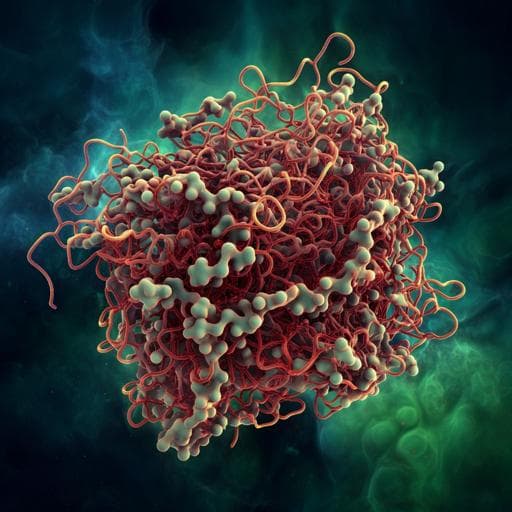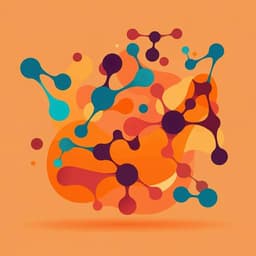
Chemistry
A universal method to easily design tough and stretchable hydrogels
C. Norioka, Y. Inamoto, et al.
Discover a groundbreaking strategy for creating tough and stretchable hydrogels that defy traditional limitations! Conducted by Chisa Norioka, Yuino Inamoto, Chika Hajime, Akifumi Kawamura, and Takashi Miyata from Kansai University, this research presents a simple approach to enhance mechanical performance through polymer chain entanglement. Expand your understanding of hydrogels and their potential applications.
~3 min • Beginner • English
Introduction
The study addresses the challenge that conventional hydrogels, despite high water content and tissue-like softness, are weak and brittle due to inhomogeneous polymer networks and limited energy dissipation. Standard hydrogels break under sub-MPa tensile stresses with fracture energies far below those of biological tissues. Prior strategies have engineered special network architectures to enhance toughness, but often require complex chemistries. The authors hypothesize that tough, stretchable hydrogels can be universally achieved by tuning polymerization to increase polymer chain entanglements while minimizing chemical cross-links, thus enhancing viscous energy dissipation. The purpose is to provide a simple, broadly applicable method—using high monomer concentration and low cross-linker content in free-radical polymerization—to form networks with many entanglements acting as mobile physical cross-links, improving toughness and extensibility without special structures.
Literature Review
Multiple structural designs have achieved tough hydrogels: sliding-ring (topological) hydrogels, nanocomposite hydrogels, and double-network (DN) hydrogels where a brittle, densely cross-linked first network and a ductile, sparsely cross-linked second network yield high strength and toughness via sacrificial bond breaking. Dynamic (reversible) cross-links responsive to stimuli (temperature, molecules, stress) also enable both responsiveness and toughness by allowing reversible bond dissociation for energy dissipation. Hydrogels exhibit viscoelastic behavior, with energy partially stored elastically and dissipated viscously; high chemical cross-linker content biases elastic response, producing rigid, brittle networks and stress concentration in inhomogeneous regions. These insights suggest that effective energy dissipation mechanisms are central to toughening, motivating designs that enhance viscous contributions such as via chain entanglements.
Methodology
Materials: Acrylamide (AAm), N,N'-methylenebisacrylamide (MBAA) cross-linker, N,N,N',N'-tetramethylethylenediamine (TEMED) accelerator, and ammonium persulfate (APS) initiator (Wako). 2-(Methacryloyloxy)ethyl phosphorylcholine (MPC) (NOF) for PMPC hydrogels.
PAAm hydrogel synthesis: AAm (recrystallized from benzene), MBAA, and TEMED were dissolved in deionized water (total monomer solution volume 2.42 mL). APS was dissolved separately in deionized water. Both solutions were degassed by freeze–pump–thaw and purged with Ar. APS solution (0.08 mL) was added to the monomer solution in an ice bath to avoid premature gelation. Final concentrations: APS 0.47 × 10⁻³ mol/L and TEMED 4.0 × 10⁻³ mol/L. The mixture was cast into molds made from two glass slides separated by glass spacers: 5 mm for compression specimens and 1.76 mm for tensile specimens. Copolymerization proceeded at 25 °C for 1 day. As-prepared hydrogels were demolded; swollen hydrogels were obtained by equilibrating in water.
PMPC hydrogel synthesis: MPC, MBAA, and TEMED were dissolved in deionized water (monomer solution volume 0.92 mL). APS initiator solution was prepared separately. Both solutions were degassed via six freeze–pump–thaw cycles and Ar purged. APS solution (0.08 mL) was added in an ice bath. Final concentrations: APS 0.47 × 10⁻³ mol/L and TEMED 4.0 × 10⁻³ mol/L. The mixture was cast into the same mold geometries; copolymerization at 25 °C for 1 day yielded as-prepared PMPC hydrogels.
Conversion measurement (PAAm): As-prepared gels were washed in deionized water for 2 weeks to remove unreacted species, then dried at 70 °C for 2 days to measure W_dried gel. Monomer conversion (%) = (W_dried gel / W_monomer) × 100.
Water content (PAAm): Swollen gels at equilibrium were weighed (W_swollen gel), then dried at 70 °C for 2 days to obtain W_dried gel. Water content (%) = [(W_swollen gel − W_dried gel) / W_swollen gel] × 100.
Mechanical testing: Compression tests (as-prepared and swollen PAAm and PMPC) used a Shimadzu SMT1-2-N with 10 mm/min compression rate. Tensile tests used crosshead speeds of 5, 50, and 500 mm/min. Toughness (work to fracture) was calculated as the area under the tensile stress–strain curve for unnotched samples of 20 mm gauge length.
Cross-linking density: Elastic modulus G was obtained from compression stress–strain using σ = G(α − α⁻²), where α is the thickness ratio. The slope of σ vs (α − α⁻²) gives G. Effective cross-linking density v_e was estimated via G ≈ RT v_e^(1/3).
Dynamic mechanical analysis: Performed in tension mode using a nonresonance forced vibration viscoelastometer (Rheogel-E-4000F; UBM) at 100 Hz and 50 µm amplitude. Storage modulus G', loss modulus G'', and loss factor tanδ = G''/G' were obtained to assess viscoelasticity across preparation conditions.
Design strategy: Systematically varied monomer concentration (1.0, 2.5, 5.0 mol/L) and cross-linker content (down to 0.001 mol%) to maximize physical chain entanglements while minimizing chemical cross-links, using conventional free-radical polymerization.
Key Findings
- Using high monomer concentrations (2.5 and 5.0 mol/L) with very low cross-linker contents (≤0.01 mol%) produced self-standing PAAm hydrogels with exceptional toughness despite inhomogeneous networks typical of free-radical polymerization.
- Compression: As-prepared PAAm hydrogels with cross-linker content <0.1 mol% did not fracture up to ~95% strain and ~6 MPa stress. Hydrogels with >0.1 mol% cross-linker fractured easily under compression.
- Tensile: At 2.5 mol/L monomer and <0.01 mol% cross-linker, hydrogels elongated >10× (high fracture strain). Hydrogels with ≥0.5 mol% cross-linker showed nearly linear stress–strain and brittle behavior.
- Fracture stress increased with monomer concentration. For 5.0 mol/L monomer and 0.005 mol% cross-linker, fracture stress was ~300 kPa.
- Initial tensile slopes (Young’s modulus) increased strongly with monomer concentration at fixed cross-linker content: for a given cross-linker content (reported as 5.0 mol%), moduli were 9.6 kPa (1.0 mol/L AAm), 40.0 kPa (2.5 mol/L), and 196.7 kPa (5.0 mol/L), indicating increased physical entanglements acting as mobile cross-links at higher monomer concentrations.
- Notably, as-prepared PAAm gels prepared at high monomer concentration and low cross-linker content were tougher than a benchmark homogeneous tetra-PEG hydrogel in compression (replotted from literature), despite inhomogeneous network formation via standard radical polymerization.
- Without chemical cross-linker, polymerizing AAm at 5.0 mol/L yielded a self-standing gel due to abundant entanglements, but it exhibited rapid stress relaxation (creep) for strain >2 and failed under low stress, indicating the need for a minute amount of covalent cross-links to stabilize entanglement networks.
- Swollen-state performance: After equilibrium swelling, fracture stress and strain decreased due to chain expansion and partial loosening of entanglements, yet gels prepared with high monomer concentration and low cross-linker content maintained high toughness. For swollen PAAm at 0.005 mol% cross-linker, samples with >90% water content withstood >90% compressive strain and >7× tensile elongation without fracture and recovered shape upon unloading; such swollen gels could not be cut with a knife, demonstrating remarkable toughness in aqueous conditions.
- Overall, balancing few chemical cross-links with many physical entanglements optimizes viscous energy dissipation and prevents stress concentration, yielding tough, stretchable hydrogels via a simple, universal approach.
Discussion
The findings support the hypothesis that engineering networks with many chain entanglements and minimal chemical cross-links enhances viscous energy dissipation and toughness. High monomer concentrations during polymerization increase polymer chain density and entanglement formation, providing numerous mobile physical cross-links that allow chain creep and stress relaxation under load. Introducing only minute amounts of covalent cross-links stabilizes the network to prevent excessive creep and premature failure, thereby optimizing the balance between elastic energy storage and viscous dissipation. This approach overcomes brittleness associated with high cross-linker content, which otherwise inhibits chain extension and concentrates stress in weak segments of inhomogeneous networks. The method yields as-prepared hydrogels that outperform even homogeneous tetra-PEG hydrogels, and critically, maintains high toughness in the swollen state (>90% water) with large compressive and tensile deformations and recovery, underscoring relevance to practical, aqueous applications. The strategy is conceptually universal, relying on polymer physics (entanglement-mediated dissipation) rather than specialized chemistries, and is demonstrated with PAAm and designed for extension to zwitterionic PMPC systems.
Conclusion
The study introduces a simple, universal strategy to fabricate tough, stretchable hydrogels by conventional free-radical polymerization using high monomer concentrations and very low cross-linker contents. This tuning produces networks rich in polymer chain entanglements (physical cross-links) stabilized by minimal covalent cross-links, enabling effective energy dissipation and avoiding stress concentration. The resulting PAAm hydrogels exhibit exceptional compressive and tensile toughness both as-prepared and after equilibrium swelling (>90% water), outperforming a benchmark homogeneous tetra-PEG hydrogel in toughness. The approach does not require special monomers, cross-linkers, or complex architectures, making it broadly applicable to various hydrophilic polymers, including biocompatible systems such as PMPC.
Future directions include: systematically extending the method to diverse monomer chemistries and copolymers; quantifying entanglement density and its relation to viscoelastic spectra; optimizing the minimal cross-linker content for different polymer backbones; assessing long-term mechanical stability, fatigue, and creep under cyclic loading; and evaluating biocompatibility and performance in biomedical contexts.
Limitations
Although the approach greatly enhances toughness, the networks formed via free-radical polymerization remain inherently inhomogeneous, and performance is sensitive to the precise balance of monomer concentration and cross-linker content. In the swollen state, fracture stress and strain decrease due to chain expansion and partial loosening of entanglements, indicating some loss of physical cross-linking upon swelling. Completely eliminating chemical cross-links leads to excessive creep and low stress tolerance at higher strains, demonstrating the necessity—but also tuning challenge—of minimal covalent cross-linking. The universality claim is based on polymer physics and demonstrated for PAAm (with PMPC targeted), but broader validation across additional polymers and operating conditions would strengthen generalizability.
Related Publications
Explore these studies to deepen your understanding of the subject.







